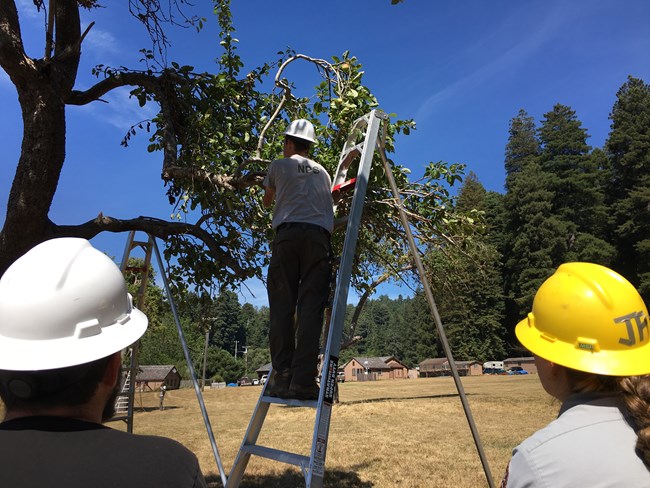Where Are the Historical Orchards?Approximately thirty percent of National Park Service units have historic fruit trees or orchards, and Redwood National and State Parks are no exception. The park is home to at least nine orchards, along with many individual fruit trees scattered throughout its landscape. The largest two orchards in the park, Lyons Ranches Home Place Orchard in the Bald Hills and the Boyes Prairie Orchard in the Elk Meadow area of Prairie Creek Redwoods State Park, contain a variety of interesting fruit species. 
California State Archives Boyes Prairie OrchardEstablished around 1884 by Andrew Harris, the Boyes Prairie Orchard was one of the first orchards in the Elk Meadow area. Harris, the first Anglo to farm the meadow, cultivated Baldwin apples on his 320-acre ranch. When he sold the property to William Boyes in 1905, the ranch included four acres of fruit trees—likely about 150 to 200 trees. Boyes then expanded the site to include a dairy and a hotel called The Oaks, which became a popular resort for hunters and fishermen. Located on the main county road and later the Redwood Highway, the inn offered hospitality and home-cooked meals prepared by Mrs. Boyes and her daughter, Ethel. Guests enjoyed locally sourced produce like honey, butter, eggs, ham, and bacon—likely complemented by fresh fruit from the orchard. Today, only 15 trees remain at the Boyes Prairie Orchard, including walnut, apple, pear, and cherry trees. The apple varieties still present—Baldwin, Rhode Island Greening, Gravenstein, and White Winter Pearmain—suggest the orchard may have been developed as a commercial operation. These apple types were all popular, reliable producers. Notably, the White Winter Pearmain, recorded as far back as 1200 A.D., was one of the first apple varieties brought to the New World by the Plymouth Colony in Massachusetts. Lyons Ranches Home Place OrchardLocated in the Bald Hills, the Lyons Ranches Home Place Orchard contains over 40 trees, including English walnut, apple, pear, cherry, and plum varieties, along with remnants of grapevines. According to a 1904 article in the Humboldt Standard, the orchard once also featured peaches and “lots of other fruit.” Jonathan and Amelia Lyons established the ranch in 1868 and became renowned for their prize-winning sheep, earning a gold medal for their wool at the 1901 World’s Fair. The ranch remained a family enterprise for many years, with their four sons—Sherman, Antonio, Anderson, and William—and grandson Gene. Like many farmers of the time, the Lyons family planted orchards both for their own use and as a cash crop. The Lyons Ranches Home Place Orchard includes some unique apple varieties, such as the giant Gloria Mundi, which can grow up to 18 inches in diameter, and the Alexander apple. These, along with the Red Astrachan, are excellent for cooking but do not store or ship well. The family also grew Baldwin apples, a popular commercial variety known for its longevity and widespread popularity in the early 20th century. In a 1902 article from the Arcata Union, it was noted that “Joe Pitt returned from Jonathan Lyons with a load of apples this week,” likely referring to the Baldwin apples from the orchard. 
Why We Preserve Historic OrchardsPreserving historic fruit and nut trees in national park sites serves multiple purposes. Fruit trees, especially long-lived apple varieties, are often the only remaining evidence of European American settlers establishing their claims on the land. These orchards hold valuable genetic information that tells the story of pioneering orchardists who developed unique varieties, and they provide a genetic stock that can be used to cultivate new varieties for future generations. In August 2019, the National Park Service conducted a training program at the Boyes Prairie Orchard, focusing on the preservation of historic orchards. Participants included students from national parks across the country, California State Parks, the US Forest Service, and orchard enthusiasts. They learned about pruning tools and techniques and practiced their skills by removing dead and damaged branches, as well as invasive vines that had overtaken one of the apple trees. The knowledge and skills gained through this training will help ensure that the Boyes Prairie Orchard, and other historic orchards throughout the country, continue to thrive for years to come. Watch Videos About Our Historic OrchardsExplore our short video episodes where various individuals share their passion and experiences in protecting and managing historic orchards. Filmed during a three-day training session in August 2019 at Boyes Prairie Orchard, these videos provide insight into the skills and dedication involved in preserving these important cultural landscapes.
|
Last updated: October 25, 2024

